Reflective Analysis: Addressing Disability in Healthcare Settings
VerifiedAdded on 2023/06/03
|7
|1744
|166
Essay
AI Summary
This essay employs the Gibbs reflective cycle to analyze a negative experience encountered during a clinical placement in aged care, specifically focusing on the care of a 78-year-old patient with dementia and mobility issues. The author reflects on the application of physical restraints due to the patient's risk of falling and subsequent dissatisfaction and bruising experienced by the patient. The reflection encompasses feelings of guilt and embarrassment, an evaluation of the intervention's inappropriateness, and an analysis of alternative, patient-centered approaches such as environmental modifications, mobility devices, and physiotherapy. The essay concludes with a commitment to developing improved care planning for patients with disabilities, emphasizing evidence-based interventions and ethical considerations, and highlights the importance of ongoing learning and mentorship to ensure quality patient care and satisfaction. The student document is available on Desklib, a platform offering a variety of study tools and resources.
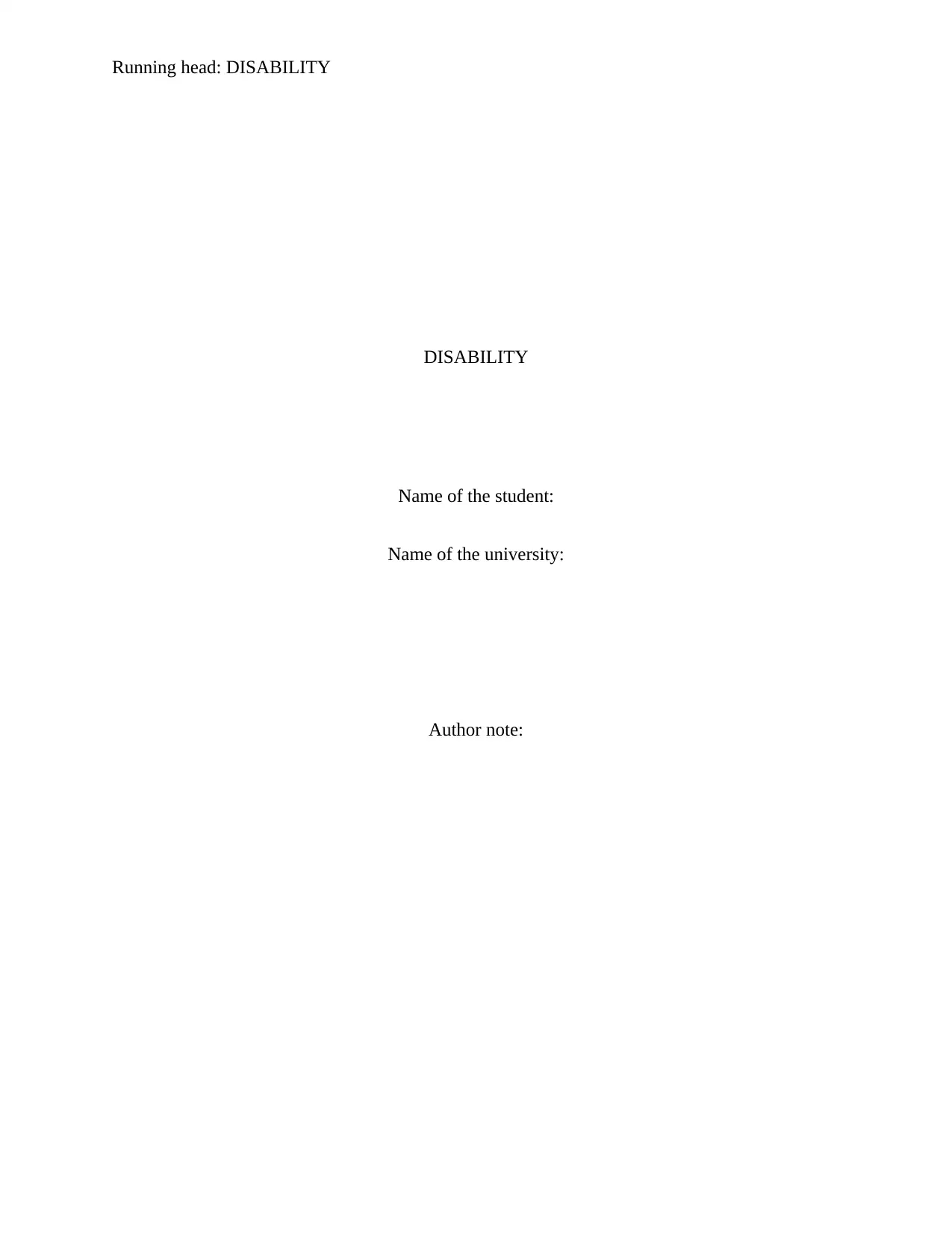
Running head: DISABILITY
DISABILITY
Name of the student:
Name of the university:
Author note:
DISABILITY
Name of the student:
Name of the university:
Author note:
Paraphrase This Document
Need a fresh take? Get an instant paraphrase of this document with our AI Paraphraser
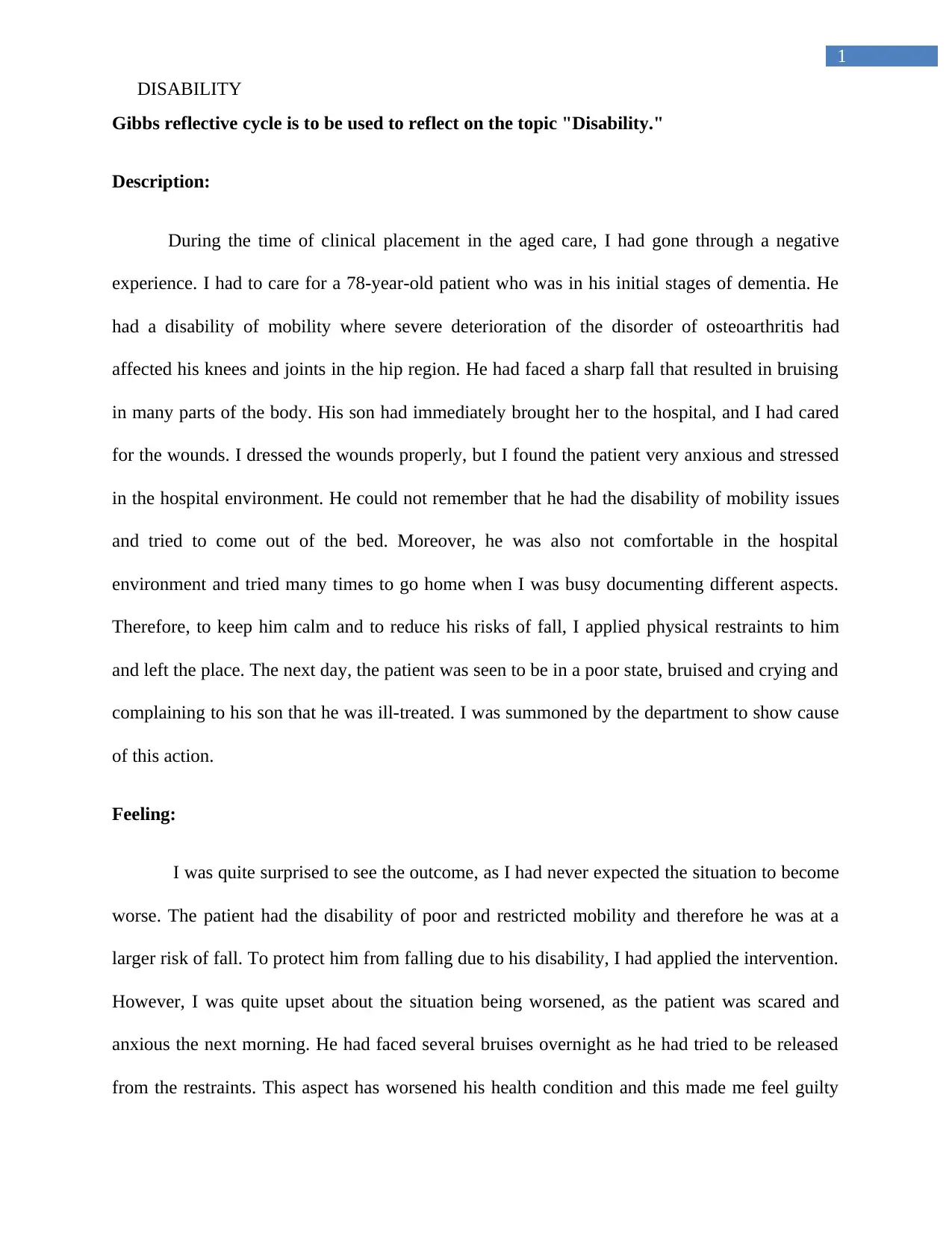
1
DISABILITY
Gibbs reflective cycle is to be used to reflect on the topic "Disability."
Description:
During the time of clinical placement in the aged care, I had gone through a negative
experience. I had to care for a 78-year-old patient who was in his initial stages of dementia. He
had a disability of mobility where severe deterioration of the disorder of osteoarthritis had
affected his knees and joints in the hip region. He had faced a sharp fall that resulted in bruising
in many parts of the body. His son had immediately brought her to the hospital, and I had cared
for the wounds. I dressed the wounds properly, but I found the patient very anxious and stressed
in the hospital environment. He could not remember that he had the disability of mobility issues
and tried to come out of the bed. Moreover, he was also not comfortable in the hospital
environment and tried many times to go home when I was busy documenting different aspects.
Therefore, to keep him calm and to reduce his risks of fall, I applied physical restraints to him
and left the place. The next day, the patient was seen to be in a poor state, bruised and crying and
complaining to his son that he was ill-treated. I was summoned by the department to show cause
of this action.
Feeling:
I was quite surprised to see the outcome, as I had never expected the situation to become
worse. The patient had the disability of poor and restricted mobility and therefore he was at a
larger risk of fall. To protect him from falling due to his disability, I had applied the intervention.
However, I was quite upset about the situation being worsened, as the patient was scared and
anxious the next morning. He had faced several bruises overnight as he had tried to be released
from the restraints. This aspect has worsened his health condition and this made me feel guilty
DISABILITY
Gibbs reflective cycle is to be used to reflect on the topic "Disability."
Description:
During the time of clinical placement in the aged care, I had gone through a negative
experience. I had to care for a 78-year-old patient who was in his initial stages of dementia. He
had a disability of mobility where severe deterioration of the disorder of osteoarthritis had
affected his knees and joints in the hip region. He had faced a sharp fall that resulted in bruising
in many parts of the body. His son had immediately brought her to the hospital, and I had cared
for the wounds. I dressed the wounds properly, but I found the patient very anxious and stressed
in the hospital environment. He could not remember that he had the disability of mobility issues
and tried to come out of the bed. Moreover, he was also not comfortable in the hospital
environment and tried many times to go home when I was busy documenting different aspects.
Therefore, to keep him calm and to reduce his risks of fall, I applied physical restraints to him
and left the place. The next day, the patient was seen to be in a poor state, bruised and crying and
complaining to his son that he was ill-treated. I was summoned by the department to show cause
of this action.
Feeling:
I was quite surprised to see the outcome, as I had never expected the situation to become
worse. The patient had the disability of poor and restricted mobility and therefore he was at a
larger risk of fall. To protect him from falling due to his disability, I had applied the intervention.
However, I was quite upset about the situation being worsened, as the patient was scared and
anxious the next morning. He had faced several bruises overnight as he had tried to be released
from the restraints. This aspect has worsened his health condition and this made me feel guilty
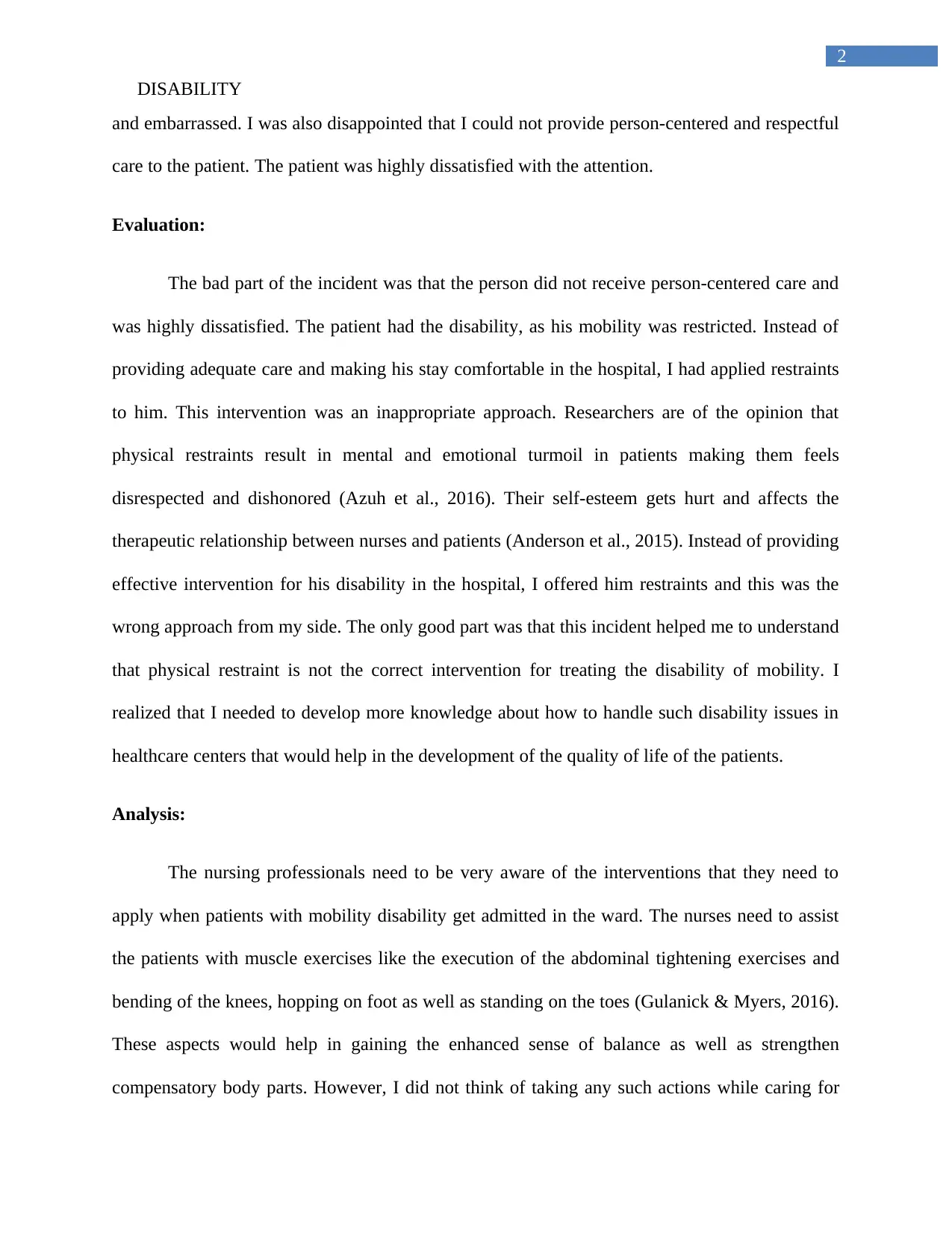
2
DISABILITY
and embarrassed. I was also disappointed that I could not provide person-centered and respectful
care to the patient. The patient was highly dissatisfied with the attention.
Evaluation:
The bad part of the incident was that the person did not receive person-centered care and
was highly dissatisfied. The patient had the disability, as his mobility was restricted. Instead of
providing adequate care and making his stay comfortable in the hospital, I had applied restraints
to him. This intervention was an inappropriate approach. Researchers are of the opinion that
physical restraints result in mental and emotional turmoil in patients making them feels
disrespected and dishonored (Azuh et al., 2016). Their self-esteem gets hurt and affects the
therapeutic relationship between nurses and patients (Anderson et al., 2015). Instead of providing
effective intervention for his disability in the hospital, I offered him restraints and this was the
wrong approach from my side. The only good part was that this incident helped me to understand
that physical restraint is not the correct intervention for treating the disability of mobility. I
realized that I needed to develop more knowledge about how to handle such disability issues in
healthcare centers that would help in the development of the quality of life of the patients.
Analysis:
The nursing professionals need to be very aware of the interventions that they need to
apply when patients with mobility disability get admitted in the ward. The nurses need to assist
the patients with muscle exercises like the execution of the abdominal tightening exercises and
bending of the knees, hopping on foot as well as standing on the toes (Gulanick & Myers, 2016).
These aspects would help in gaining the enhanced sense of balance as well as strengthen
compensatory body parts. However, I did not think of taking any such actions while caring for
DISABILITY
and embarrassed. I was also disappointed that I could not provide person-centered and respectful
care to the patient. The patient was highly dissatisfied with the attention.
Evaluation:
The bad part of the incident was that the person did not receive person-centered care and
was highly dissatisfied. The patient had the disability, as his mobility was restricted. Instead of
providing adequate care and making his stay comfortable in the hospital, I had applied restraints
to him. This intervention was an inappropriate approach. Researchers are of the opinion that
physical restraints result in mental and emotional turmoil in patients making them feels
disrespected and dishonored (Azuh et al., 2016). Their self-esteem gets hurt and affects the
therapeutic relationship between nurses and patients (Anderson et al., 2015). Instead of providing
effective intervention for his disability in the hospital, I offered him restraints and this was the
wrong approach from my side. The only good part was that this incident helped me to understand
that physical restraint is not the correct intervention for treating the disability of mobility. I
realized that I needed to develop more knowledge about how to handle such disability issues in
healthcare centers that would help in the development of the quality of life of the patients.
Analysis:
The nursing professionals need to be very aware of the interventions that they need to
apply when patients with mobility disability get admitted in the ward. The nurses need to assist
the patients with muscle exercises like the execution of the abdominal tightening exercises and
bending of the knees, hopping on foot as well as standing on the toes (Gulanick & Myers, 2016).
These aspects would help in gaining the enhanced sense of balance as well as strengthen
compensatory body parts. However, I did not think of taking any such actions while caring for
⊘ This is a preview!⊘
Do you want full access?
Subscribe today to unlock all pages.

Trusted by 1+ million students worldwide
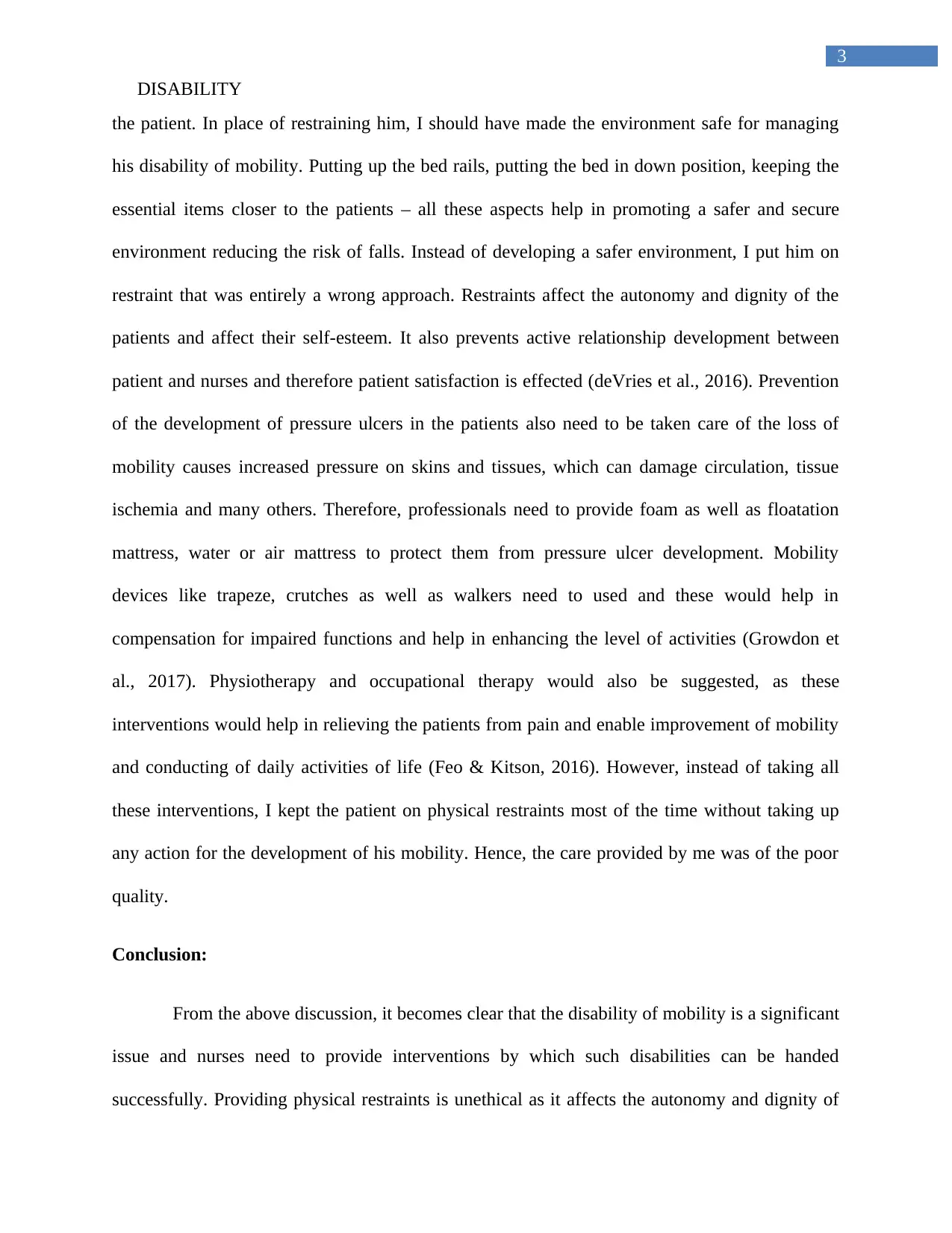
3
DISABILITY
the patient. In place of restraining him, I should have made the environment safe for managing
his disability of mobility. Putting up the bed rails, putting the bed in down position, keeping the
essential items closer to the patients – all these aspects help in promoting a safer and secure
environment reducing the risk of falls. Instead of developing a safer environment, I put him on
restraint that was entirely a wrong approach. Restraints affect the autonomy and dignity of the
patients and affect their self-esteem. It also prevents active relationship development between
patient and nurses and therefore patient satisfaction is effected (deVries et al., 2016). Prevention
of the development of pressure ulcers in the patients also need to be taken care of the loss of
mobility causes increased pressure on skins and tissues, which can damage circulation, tissue
ischemia and many others. Therefore, professionals need to provide foam as well as floatation
mattress, water or air mattress to protect them from pressure ulcer development. Mobility
devices like trapeze, crutches as well as walkers need to used and these would help in
compensation for impaired functions and help in enhancing the level of activities (Growdon et
al., 2017). Physiotherapy and occupational therapy would also be suggested, as these
interventions would help in relieving the patients from pain and enable improvement of mobility
and conducting of daily activities of life (Feo & Kitson, 2016). However, instead of taking all
these interventions, I kept the patient on physical restraints most of the time without taking up
any action for the development of his mobility. Hence, the care provided by me was of the poor
quality.
Conclusion:
From the above discussion, it becomes clear that the disability of mobility is a significant
issue and nurses need to provide interventions by which such disabilities can be handed
successfully. Providing physical restraints is unethical as it affects the autonomy and dignity of
DISABILITY
the patient. In place of restraining him, I should have made the environment safe for managing
his disability of mobility. Putting up the bed rails, putting the bed in down position, keeping the
essential items closer to the patients – all these aspects help in promoting a safer and secure
environment reducing the risk of falls. Instead of developing a safer environment, I put him on
restraint that was entirely a wrong approach. Restraints affect the autonomy and dignity of the
patients and affect their self-esteem. It also prevents active relationship development between
patient and nurses and therefore patient satisfaction is effected (deVries et al., 2016). Prevention
of the development of pressure ulcers in the patients also need to be taken care of the loss of
mobility causes increased pressure on skins and tissues, which can damage circulation, tissue
ischemia and many others. Therefore, professionals need to provide foam as well as floatation
mattress, water or air mattress to protect them from pressure ulcer development. Mobility
devices like trapeze, crutches as well as walkers need to used and these would help in
compensation for impaired functions and help in enhancing the level of activities (Growdon et
al., 2017). Physiotherapy and occupational therapy would also be suggested, as these
interventions would help in relieving the patients from pain and enable improvement of mobility
and conducting of daily activities of life (Feo & Kitson, 2016). However, instead of taking all
these interventions, I kept the patient on physical restraints most of the time without taking up
any action for the development of his mobility. Hence, the care provided by me was of the poor
quality.
Conclusion:
From the above discussion, it becomes clear that the disability of mobility is a significant
issue and nurses need to provide interventions by which such disabilities can be handed
successfully. Providing physical restraints is unethical as it affects the autonomy and dignity of
Paraphrase This Document
Need a fresh take? Get an instant paraphrase of this document with our AI Paraphraser
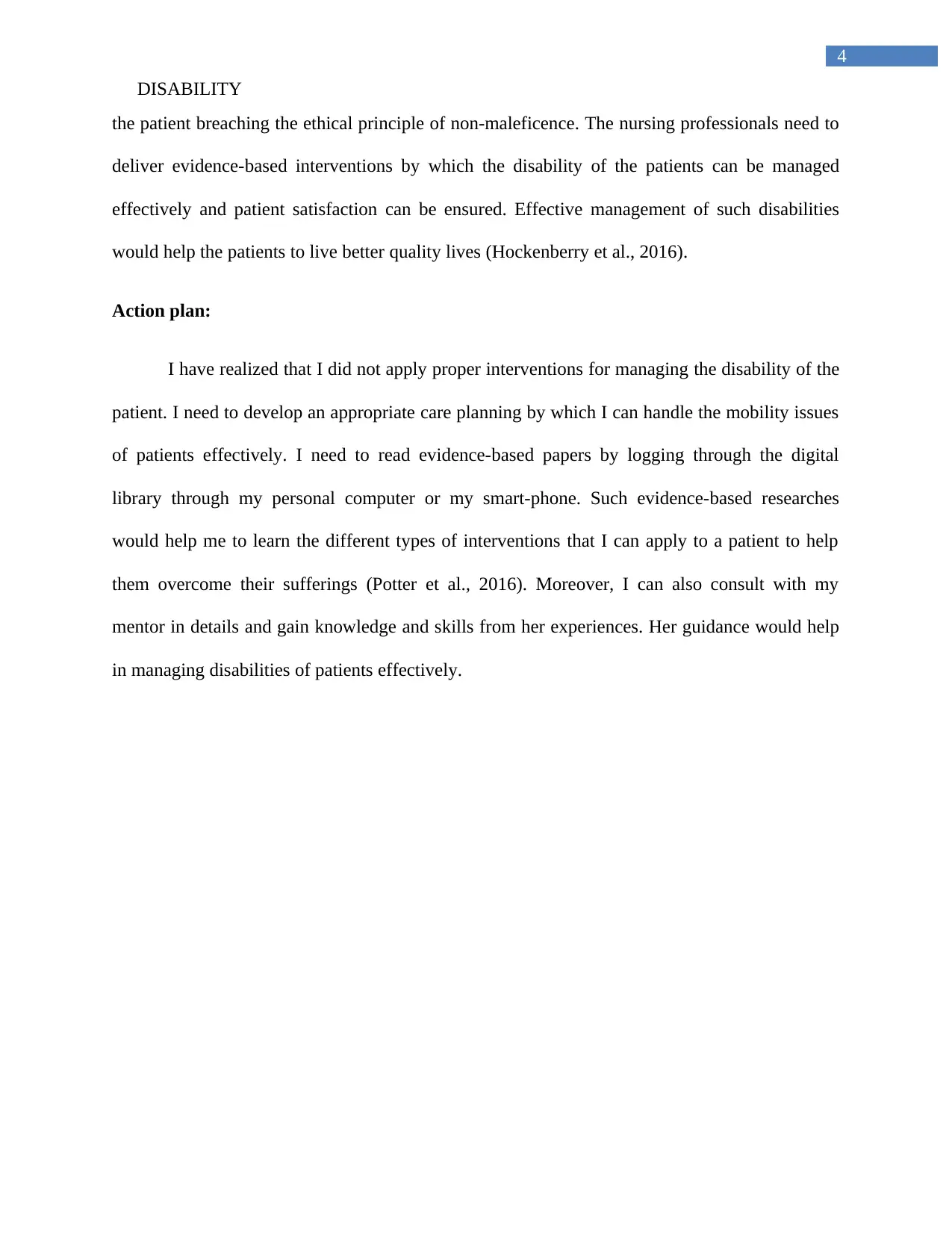
4
DISABILITY
the patient breaching the ethical principle of non-maleficence. The nursing professionals need to
deliver evidence-based interventions by which the disability of the patients can be managed
effectively and patient satisfaction can be ensured. Effective management of such disabilities
would help the patients to live better quality lives (Hockenberry et al., 2016).
Action plan:
I have realized that I did not apply proper interventions for managing the disability of the
patient. I need to develop an appropriate care planning by which I can handle the mobility issues
of patients effectively. I need to read evidence-based papers by logging through the digital
library through my personal computer or my smart-phone. Such evidence-based researches
would help me to learn the different types of interventions that I can apply to a patient to help
them overcome their sufferings (Potter et al., 2016). Moreover, I can also consult with my
mentor in details and gain knowledge and skills from her experiences. Her guidance would help
in managing disabilities of patients effectively.
DISABILITY
the patient breaching the ethical principle of non-maleficence. The nursing professionals need to
deliver evidence-based interventions by which the disability of the patients can be managed
effectively and patient satisfaction can be ensured. Effective management of such disabilities
would help the patients to live better quality lives (Hockenberry et al., 2016).
Action plan:
I have realized that I did not apply proper interventions for managing the disability of the
patient. I need to develop an appropriate care planning by which I can handle the mobility issues
of patients effectively. I need to read evidence-based papers by logging through the digital
library through my personal computer or my smart-phone. Such evidence-based researches
would help me to learn the different types of interventions that I can apply to a patient to help
them overcome their sufferings (Potter et al., 2016). Moreover, I can also consult with my
mentor in details and gain knowledge and skills from her experiences. Her guidance would help
in managing disabilities of patients effectively.
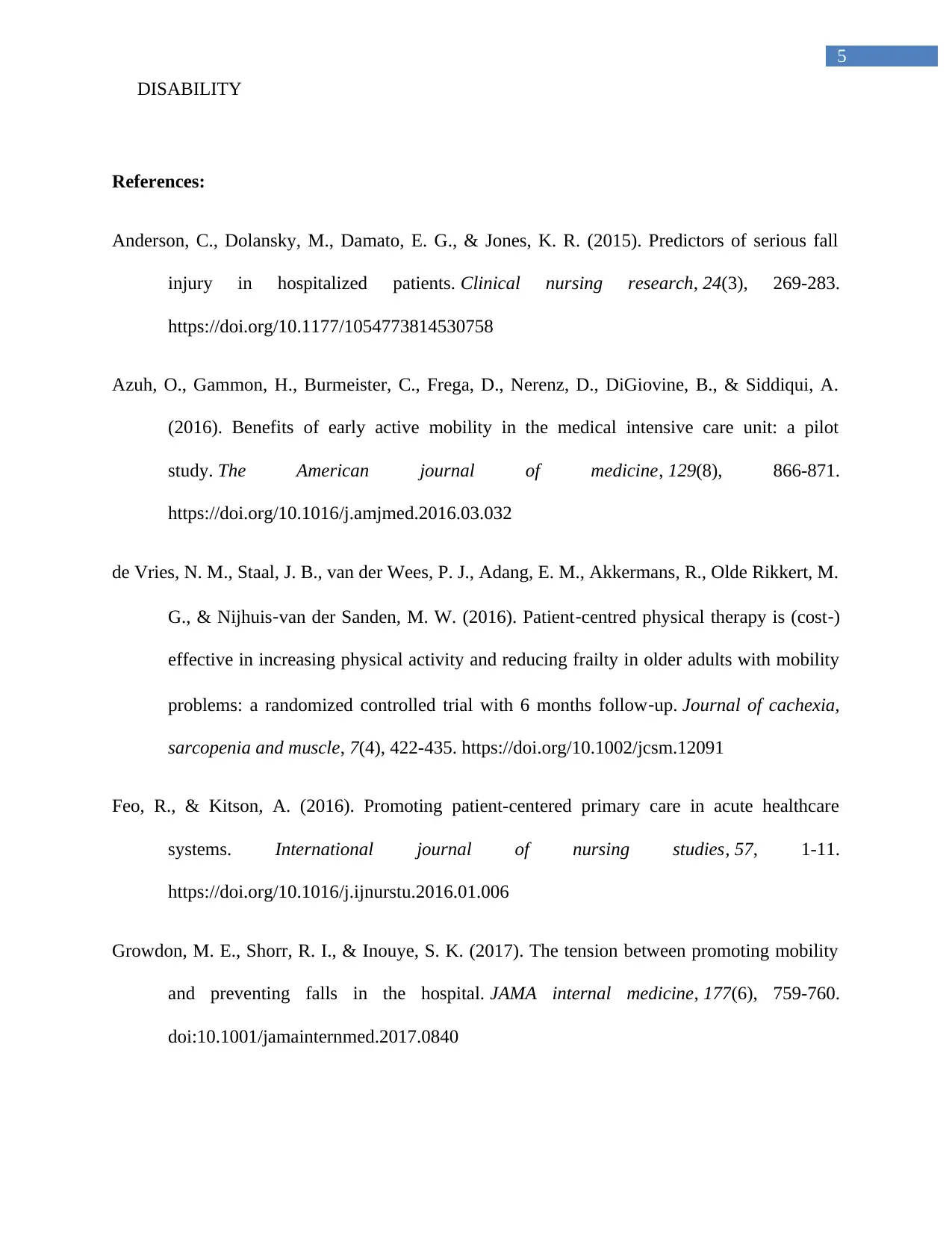
5
DISABILITY
References:
Anderson, C., Dolansky, M., Damato, E. G., & Jones, K. R. (2015). Predictors of serious fall
injury in hospitalized patients. Clinical nursing research, 24(3), 269-283.
https://doi.org/10.1177/1054773814530758
Azuh, O., Gammon, H., Burmeister, C., Frega, D., Nerenz, D., DiGiovine, B., & Siddiqui, A.
(2016). Benefits of early active mobility in the medical intensive care unit: a pilot
study. The American journal of medicine, 129(8), 866-871.
https://doi.org/10.1016/j.amjmed.2016.03.032
de Vries, N. M., Staal, J. B., van der Wees, P. J., Adang, E. M., Akkermans, R., Olde Rikkert, M.
G., & Nijhuis‐van der Sanden, M. W. (2016). Patient‐centred physical therapy is (cost‐)
effective in increasing physical activity and reducing frailty in older adults with mobility
problems: a randomized controlled trial with 6 months follow‐up. Journal of cachexia,
sarcopenia and muscle, 7(4), 422-435. https://doi.org/10.1002/jcsm.12091
Feo, R., & Kitson, A. (2016). Promoting patient-centered primary care in acute healthcare
systems. International journal of nursing studies, 57, 1-11.
https://doi.org/10.1016/j.ijnurstu.2016.01.006
Growdon, M. E., Shorr, R. I., & Inouye, S. K. (2017). The tension between promoting mobility
and preventing falls in the hospital. JAMA internal medicine, 177(6), 759-760.
doi:10.1001/jamainternmed.2017.0840
DISABILITY
References:
Anderson, C., Dolansky, M., Damato, E. G., & Jones, K. R. (2015). Predictors of serious fall
injury in hospitalized patients. Clinical nursing research, 24(3), 269-283.
https://doi.org/10.1177/1054773814530758
Azuh, O., Gammon, H., Burmeister, C., Frega, D., Nerenz, D., DiGiovine, B., & Siddiqui, A.
(2016). Benefits of early active mobility in the medical intensive care unit: a pilot
study. The American journal of medicine, 129(8), 866-871.
https://doi.org/10.1016/j.amjmed.2016.03.032
de Vries, N. M., Staal, J. B., van der Wees, P. J., Adang, E. M., Akkermans, R., Olde Rikkert, M.
G., & Nijhuis‐van der Sanden, M. W. (2016). Patient‐centred physical therapy is (cost‐)
effective in increasing physical activity and reducing frailty in older adults with mobility
problems: a randomized controlled trial with 6 months follow‐up. Journal of cachexia,
sarcopenia and muscle, 7(4), 422-435. https://doi.org/10.1002/jcsm.12091
Feo, R., & Kitson, A. (2016). Promoting patient-centered primary care in acute healthcare
systems. International journal of nursing studies, 57, 1-11.
https://doi.org/10.1016/j.ijnurstu.2016.01.006
Growdon, M. E., Shorr, R. I., & Inouye, S. K. (2017). The tension between promoting mobility
and preventing falls in the hospital. JAMA internal medicine, 177(6), 759-760.
doi:10.1001/jamainternmed.2017.0840
⊘ This is a preview!⊘
Do you want full access?
Subscribe today to unlock all pages.

Trusted by 1+ million students worldwide
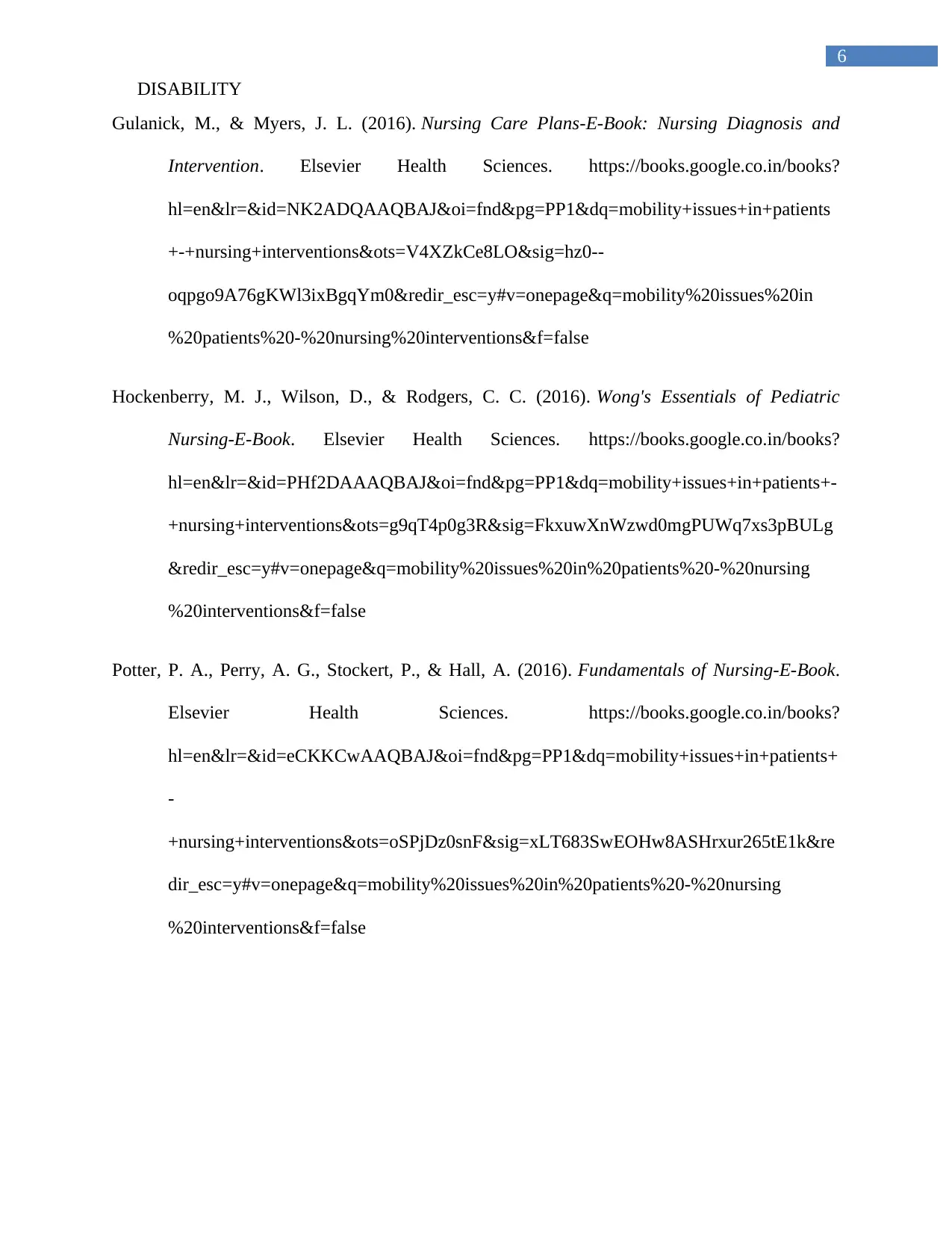
6
DISABILITY
Gulanick, M., & Myers, J. L. (2016). Nursing Care Plans-E-Book: Nursing Diagnosis and
Intervention. Elsevier Health Sciences. https://books.google.co.in/books?
hl=en&lr=&id=NK2ADQAAQBAJ&oi=fnd&pg=PP1&dq=mobility+issues+in+patients
+-+nursing+interventions&ots=V4XZkCe8LO&sig=hz0--
oqpgo9A76gKWl3ixBgqYm0&redir_esc=y#v=onepage&q=mobility%20issues%20in
%20patients%20-%20nursing%20interventions&f=false
Hockenberry, M. J., Wilson, D., & Rodgers, C. C. (2016). Wong's Essentials of Pediatric
Nursing-E-Book. Elsevier Health Sciences. https://books.google.co.in/books?
hl=en&lr=&id=PHf2DAAAQBAJ&oi=fnd&pg=PP1&dq=mobility+issues+in+patients+-
+nursing+interventions&ots=g9qT4p0g3R&sig=FkxuwXnWzwd0mgPUWq7xs3pBULg
&redir_esc=y#v=onepage&q=mobility%20issues%20in%20patients%20-%20nursing
%20interventions&f=false
Potter, P. A., Perry, A. G., Stockert, P., & Hall, A. (2016). Fundamentals of Nursing-E-Book.
Elsevier Health Sciences. https://books.google.co.in/books?
hl=en&lr=&id=eCKKCwAAQBAJ&oi=fnd&pg=PP1&dq=mobility+issues+in+patients+
-
+nursing+interventions&ots=oSPjDz0snF&sig=xLT683SwEOHw8ASHrxur265tE1k&re
dir_esc=y#v=onepage&q=mobility%20issues%20in%20patients%20-%20nursing
%20interventions&f=false
DISABILITY
Gulanick, M., & Myers, J. L. (2016). Nursing Care Plans-E-Book: Nursing Diagnosis and
Intervention. Elsevier Health Sciences. https://books.google.co.in/books?
hl=en&lr=&id=NK2ADQAAQBAJ&oi=fnd&pg=PP1&dq=mobility+issues+in+patients
+-+nursing+interventions&ots=V4XZkCe8LO&sig=hz0--
oqpgo9A76gKWl3ixBgqYm0&redir_esc=y#v=onepage&q=mobility%20issues%20in
%20patients%20-%20nursing%20interventions&f=false
Hockenberry, M. J., Wilson, D., & Rodgers, C. C. (2016). Wong's Essentials of Pediatric
Nursing-E-Book. Elsevier Health Sciences. https://books.google.co.in/books?
hl=en&lr=&id=PHf2DAAAQBAJ&oi=fnd&pg=PP1&dq=mobility+issues+in+patients+-
+nursing+interventions&ots=g9qT4p0g3R&sig=FkxuwXnWzwd0mgPUWq7xs3pBULg
&redir_esc=y#v=onepage&q=mobility%20issues%20in%20patients%20-%20nursing
%20interventions&f=false
Potter, P. A., Perry, A. G., Stockert, P., & Hall, A. (2016). Fundamentals of Nursing-E-Book.
Elsevier Health Sciences. https://books.google.co.in/books?
hl=en&lr=&id=eCKKCwAAQBAJ&oi=fnd&pg=PP1&dq=mobility+issues+in+patients+
-
+nursing+interventions&ots=oSPjDz0snF&sig=xLT683SwEOHw8ASHrxur265tE1k&re
dir_esc=y#v=onepage&q=mobility%20issues%20in%20patients%20-%20nursing
%20interventions&f=false
1 out of 7
Related Documents
Your All-in-One AI-Powered Toolkit for Academic Success.
+13062052269
info@desklib.com
Available 24*7 on WhatsApp / Email
![[object Object]](/_next/static/media/star-bottom.7253800d.svg)
Unlock your academic potential
Copyright © 2020–2025 A2Z Services. All Rights Reserved. Developed and managed by ZUCOL.





